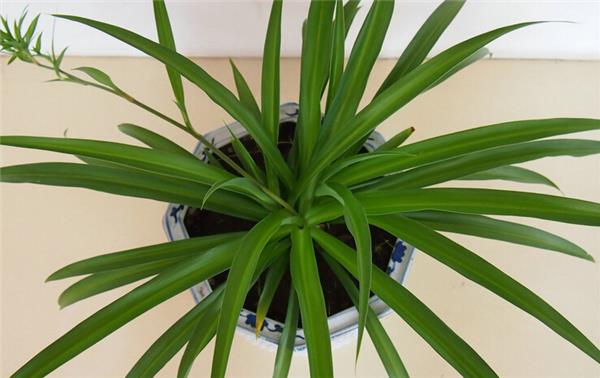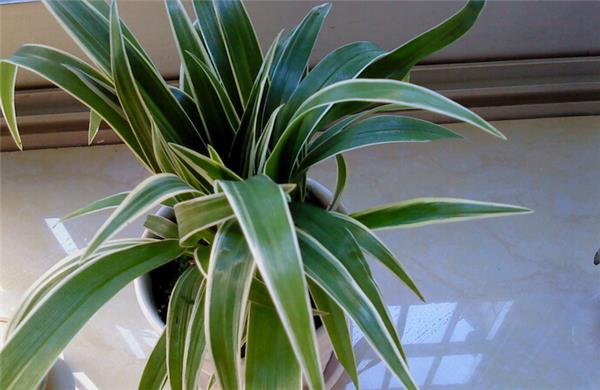What's the difference between different varieties of Cymbidium?
Cymbidium is a perennial green herb with short rhizomes, thick and short root tails, white flowers and sometimes cyan flowers with linear leaves with green and yellow stripes in the middle. The leaves clustered at the top of the stem droop outward from the edge of the basin, fluttering with the wind, like a crane that spreads its wings. So the hanging orchid also has a good-sounding name called folding crane, there are many varieties of the hanging orchid, the following introduces the variety of the hanging orchid.

Introduction to the varieties of Cymbidium
There are many kinds of hanging orchids, each with different forms and characteristics. There are five common ones: such as orchids, purple orchids, flower orchids, gold leaf orchids, silver-edged orchids.
Cymbidium: the stem is not separated from the leaf, the leaf is drooping, the leaf is dark green, it blossoms in June or July every year, and the flowers are yellowish and white.
Purple orchid: also known as color leaf orchid, the main vein of the leaf is purple, the branches are nodular, each node leaves, the leaves are thick and shiny, are drooping, blooming from June to October every year, pink.
Cymbidium: the branches are trailing, the branches and leaves are drooping, the leaves are peach-shaped, the edges of the leaves are golden, and pass through the center of the veins, and the back of the leaves is purple and gives off light.
Phnom Penh orchid: there are yellow lines on the green leaves around the leaves, which look especially good to match.
Silver-edged hanging orchid: the green leaves are painted with white edges, which are more bright and distinctive.
Magnolia lanceolata: the center of the leaf has a yellow longitudinal stripe.
Magnolia lanceolata: there are silver-white longitudinal stripes around the main vein of the leaf.
Broad-leaf orchid: the blade is broadly linear, entire or slightly wrinkled. Scape is extracted from the leaves and forms a creeping stem after flowering, which can take root and sprout and grow into a new plant in spring and summer. Capsule triangular-angled-oblate.

Cymbidium: the leaves are long and narrow, lanceolate, milky white with green stripes and edges.
Hanging orchid roots and leaves, creeping growth, when the breeze blowing, just like a green butterfly dance, like a "green fairy". As a potted flower, Cymbidium has great ornamental value. There are many kinds of hanging orchids, such as Phnom Penh, Silver orchid, Golden Heart Cymbidium, and so on. Today, the editor will introduce some common varieties of Cymbidium to you in detail.
Detailed introduction of common varieties of Cymbidium
"Golden Leaf hanging Orchid"
Gold leaf hanging orchid is generally divided into Phnom Penh hanging orchid and gold heart hanging orchid, the former has yellow lines around the green leaves, a bit like a frame, the shape is unique and very good-looking; hearing its name, the golden orchid knows that the center of the leaf is yellow longitudinal stripes, looks exquisite and atmospheric, is now the largest variety on the market, hanging on the wall is a good choice.

Silver leaf hanging orchid
The species of silver leaf orchid and gold leaf orchid are the same, there are silver orchid and silver orchid, silver stripes around silver orchid look elegant and clean, can purify people's mind; silver orchid leaves in the middle, branches and leaves are not separated, leaves drooping, leaves show dark green, blooming in June and July every year, the flowers are yellowish and white. The white center stripes make the eyes look more bright and distinctive.
"wide leaf hanging orchid"
The leaves are a little wider and linear than other orchids, and the edges sometimes have slight wrinkles; the scape is drawn from the leaves and forms a creeping stem after flowering, and it can also split into new ones, which usually bloom in spring or summer. On a hot summer day, if there is such a fresh floret, it will certainly be much cooler, and the fruit of the orchid is round and flat, which looks lovely and interesting.
Purple hanging orchid
"Ninja Frost deceives bamboo and cypress, willing to hang Lansun with the snow moon" is an ancient literati's poem about hanging orchid. Purple Cymbidium is one of the more valuable varieties of Cymbidium. Its branches are nodular, each node has leaves, the petiole is all purplish red, the leaves are thicker and glossy, and they all look like drooping, blooming from June to October every year, usually pink flowers, is not more dreamy.

When it comes to the role of hanging orchids, it is really too big. The orchid can absorb more than 80% of the harmful gases in the room, absorb 86% of the formaldehyde, and absorb all the carbon monoxide and nitrogen peroxide emitted by stoves, electrical appliances and plastic products. For us in modern urban life, we often face the radiation emitted by all kinds of digital products. If we put one or two pots of orchids next to us, the poisonous gases in the air will be absorbed, which is equivalent to an air purifier. Therefore, the hanging orchid is also known as the "green purifier". So, what problems should be paid attention to in the process of breeding?
Problems needing attention in Cymbidium Culture
The substrate of how to raise Cymbidium: Cymbidium has strong adaptability to all kinds of soil and is easy to be cultivated. A small amount of base fertilizer can be added to prepare fertile sandy loam, humus, peat or fine sandy soil.
How to breed Cymbidium: Cymbidium has strong adaptability and high survival rate, and it is often propagated by means of ramet, cuttage, sowing and so on. Cuttings and ramet propagation can be carried out at any time from spring to autumn.
How to water the hanging orchid: the hanging orchid likes the wet environment, and the basin soil should always keep the supermarket. Because its fleshy root can store a lot of water, it has a strong ability to resist drought and does not need to be watered frequently. Less than 5 degrees in winter, should be less watering, basin soil should not be too wet, otherwise the leaves are easy to yellowing.
How to fertilize the orchid: apply liquid fertilizer every 3 weeks during the growing season. Apply less nitrogen fertilizer and stop fertilization if the ambient temperature is lower than 10 degrees.
How to raise the light of the hanging orchid: the hanging orchid likes the semi-shady environment, but it can be cultivated in a bright indoor environment all the year round. It is best to find a place where there can be scattered sunlight, or to cover 50% and 70% of the sunlight with gauze curtains, so that it can grow luxuriantly and have beautiful leaves.

How to raise the temperature of the orchid: the orchid is resistant to high temperature, the suitable growth temperature is between 15-30 ℃, and the winter temperature is above 10 ℃.
How to maintain the humidity of the hanging orchid: the hanging orchid likes the wet environment, in order to make it fresh and fresh green, it can often spray water to clean the leaves.
How to prune the orchid: as the plant grows, in order to maintain a good plant type, the yellow leaves at the base and leaf tip should be cut frequently, and pay attention to the pruning of some old and rotten roots.
Pest control of how to raise Cymbidium: Cymbidium is dense and unventilated and is vulnerable to scale insects, so prevention should be given priority to.

There are many varieties of Orchidaceae, and the favorite is Phnom Penh, because it will look more beautiful in the sun, and the plant is shaped like a blooming flower, with the title of "king of formaldehyde removal". How can people not like such a beautiful and practical plant?
Often in the face of radiation emitted by a variety of digital products, put 1 to 2 pots of orchid next to it, the poisonous gas in the air is absorbed, it is equivalent to an air purifier, so the orchid is also known as "green purifier". So, what problems should be paid attention to in the process of breeding?
Problems needing attention in Cymbidium Culture
The substrate of how to raise Cymbidium: Cymbidium has strong adaptability to all kinds of soil and is easy to be cultivated. A small amount of base fertilizer can be added to prepare fertile sandy loam, humus, peat or fine sandy soil.
How to breed Cymbidium: Cymbidium has strong adaptability and high survival rate, and it is often propagated by means of ramet, cuttage, sowing and so on. Cuttings and ramet propagation can be carried out at any time from spring to autumn.
How to water the hanging orchid: the hanging orchid likes the wet environment, and the basin soil should always keep the supermarket. Because its fleshy root can store a lot of water, it has a strong ability to resist drought and does not need to be watered frequently. Less than 5 degrees in winter, should be less watering, basin soil should not be too wet, otherwise the leaves are easy to yellowing.
How to fertilize the orchid: apply liquid fertilizer every 3 weeks during the growing season. Apply less nitrogen fertilizer and stop fertilization if the ambient temperature is lower than 10 degrees.
How to raise the light of the hanging orchid: the hanging orchid likes the semi-shady environment, but it can be cultivated in a bright indoor environment all the year round. It is best to find a place where there can be scattered sunlight, or to cover 50% and 70% of the sunlight with gauze curtains, so that it can grow luxuriantly and have beautiful leaves.

How to raise the temperature of the orchid: the orchid is resistant to high temperature, the suitable growth temperature is between 15-30 ℃, and the winter temperature is above 10 ℃.
How to maintain the humidity of the hanging orchid: the hanging orchid likes the wet environment, in order to make it fresh and fresh green, it can often spray water to clean the leaves.
How to prune the orchid: as the plant grows, in order to maintain a good plant type, the yellow leaves at the base and leaf tip should be cut frequently, and pay attention to the pruning of some old and rotten roots.
Pest control of how to raise Cymbidium: Cymbidium is dense and unventilated and is vulnerable to scale insects, so prevention should be given priority to.

There are many varieties of Orchidaceae, and the favorite is Phnom Penh, because it will look more beautiful in the sun, and the plant is shaped like a blooming flower, with the title of "king of formaldehyde removal". How can people not like such a beautiful and practical plant?
Related
- Wuhan Hospital Iron Tree Blooming Result Was Instantly Frightened by the Gardener Master
- Which variety of camellia is the most fragrant and best? Which one do you like best?
- What is the small blue coat, the breeding methods and matters needing attention of the succulent plant
- Dormancy time and maintenance management of succulent plants during dormancy
- Minas succulent how to raise, Minas succulent plant pictures
- What are the varieties of winter succulent plants
- How to raise succulent plants in twelve rolls? let's take a look at some experience of breeding twelve rolls.
- Attention should be paid to water control for succulent plants during dormant period (winter and summer)
- Watering experience of twelve rolls of succulent plants
- Techniques for fertilizing succulent plants. An article will let you know how to fertilize succulent plants.



